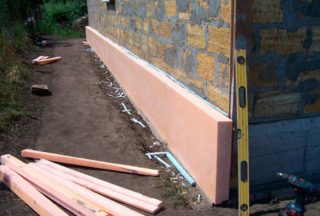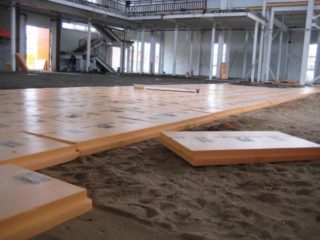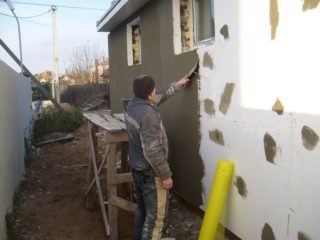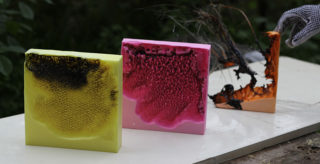The modern market of thermal insulation materials offers customers a rich assortment of quality products. One of the most popular and popular are polystyrene and polystyrene. They are often confused, so it’s worthwhile to figure out how the polystyrene differs from polystyrene foam in order to choose the most suitable insulation for your home, garage, cellar or barn.
Description of materials
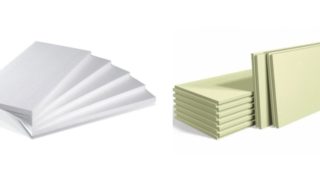
Externally, the materials are similar and their scope is one. But there are still differences.
Styrofoam
The material is a foamed plastic. This is not a specific insulation, but a whole group. Expanded polystyrene is also a type of foam. There are two types of this material - dieless and extruded. Speaking of polystyrene, they mean the first variety.
In the manufacture of insulation polystyrene is used. The granules of the material are processed with dry steam. They expand due to heating, due to which they interlock with each other. At the same time, micropores remain between the granules, which reduce strength - even slight pressure is enough to insulate the insulation.
Expanded polystyrene
In the manufacture of the material, polystyrene granules are extruded - fused to each other at high temperature, and then pressed to increase the strength of the insulation. As a result, molecular bonds arise, because of which it will not be possible to crush a sheet of heat-insulating material, simply squeezing it in your hands. Due to the absence of micropores between the granules, the thermal conductivity increases slightly.
Comparison of Styrofoam and Styrofoam
In order to choose the optimal insulation for specific purposes, the technical characteristics of the material should be taken into account.
Thermal conductivity
This is one of the most important indicators that you need to pay attention to when choosing a suitable thermal insulation material. It depends on how high-quality and effective the insulation of the house or any other building will become.
Expanded polystyrene is the leader here. Its thermal conductivity is 0.028 W / m * K, while the foam has an indicator one and a half times greater - 0.039.
With high-quality insulation, the heat loss of the building when using expanded polystyrene is significantly reduced.
Mechanical strength
The indicator by which two similar in appearance materials differ greatly. It becomes especially important if it is planned to insulate the walls from the outside, since the insulation will have to withstand certain loads. At the same time, it should not break - any crack will turn into a cold bridge, which significantly reduces the efficiency of thermal insulation. It is necessary to take into account the load not only on compression, but also on bending.
Here, expanded polystyrene also outperforms polystyrene. It withstands pressure in the region of 0.4-1 MPa and a bending load of about 0.25-0.5 MPa. Such a significant spread is explained by different brands of insulation, as well as the thickness of the sheets. Similar indicators of the foam are 0.05-0.2 and 0.07-0.2 MPa. Therefore, if a heater is needed that can withstand quite large loads, it is better to give preference to expanded polystyrene - it will last much longer.
High strength allows you to make various products from expanded polystyrene - ceiling tiles, skirting boards and much more.
Water absorption ability
In humid climates, this parameter must be considered. If the insulation is saturated with moisture, its thermal insulation properties will sharply decrease and its efficiency will drop significantly. Chemical heaters are not subject to decay, they dry quickly and return to their original characteristics, but it is better to choose a material that practically does not absorb water.
To determine the hydrophobicity, the insulating material is immersed in water for 24 hours and 30 days. Polyfoam for this absorbs quite a lot of water - 2% of the volume of insulation per day and 4% per month. Micropores between granules quickly fill with moisture. Because of this, it is recommended to use the material indoors or to protect it with high-quality waterproofing in order to minimize contact with moisture.
Expanded polystyrene absorbs water much worse - its indicators are 0.2 and 0.4%, respectively - it absorbs moisture ten times worse. The material can be used to warm the external walls of the house.
Fire resistance
If you have to insulate a wooden building, fire resistance is a particularly important indicator. When working with any other buildings, you should not forget about it either.
Here, both materials appear not in the best light. Their combustibility indicators correspond to classes G2 or G3. The specific characteristic depends on additional impurities that can be used in the manufacture of heaters. In any case, it is enough to bring a match so that they flare up and continue to burn until they burn out completely.
Shrink tendency
Shrinkage is a serious problem when using insulation. If the material changes its shape even a little, gaps will appear between the sheets, which reduce the efficiency of thermal insulation.
Expanded polystyrene practically does not shrink even with many years of use - this is a very important plus.
The foam can become slightly deformed if subjected to constant heating - for example, in combination with warm floors or when exposed to sunlight. Therefore, it is recommended to protect it with white plaster, blocking ultraviolet.
Scope of materials
Polyfoam and polystyrene foam can be used to warm buildings - in general, the scope of use is quite close. An additional plus is the ease of laying and fitting, resistance to shrinkage. However, expanded polystyrene is a more popular insulation. It has lower thermal conductivity and resistance to water, better strength. Therefore, it can be used for insulation of any surfaces, including floors.
Polyfoam begins to crumble even with minor loads. Rodents love him, they can make a whole network of tunnels in the insulation, which reduce the thermal insulation ability. Therefore, it is better to use it for the insulation of walls and ceilings in houses and apartments where active pest control is ongoing.
